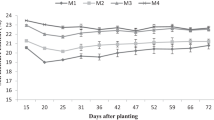Abstract
Sweet corn has a short growing period of 80 to 90 days in Korea, which allows famers to grow this crop using various cropping systems. This objective of this study was to find the optimum plant density for Korean sweet corn (se) hybrids ‘Godangok’ and ‘Guseulok’ when they were grown as the second crop. Plant densities were 5,710, 6,670, and 8,000 plants 10a-1 and planting dates were 20 July and 30 July, 2013. There was no interactive effect between plant density and hybrid for all the analyzed parameters in this study. Increasing plant density up to 8,000 plants 10a-1 led to no significant gain in marketable ear yield. Although the total number of ears was increased about 21 ç 33% at the highest plant density than at lower densities, e.g., 6,670 or 5,710 plants 10a-1, the percentage of marketable ear number and individual ear weight decreased with increasing plant density. Individual ear weight of marketable ears was significantly greater, e.g., by 8 ç 13%, at 5,710 plants 10a-1 and 6,670 plants 10a-1 than at 8,000 plants 10a-1. Similar results were obtained for ear length and width and filled length under the given plant densities, which indicated that increasing plant density may decrease individual ear fresh weight and ear size with good tip fill. Increasing plant density up to 8,000 plants 10a-1 caused the lowest harvest index, which resulted in little gain in fresh ear yield compared to the lower plant densities of 5,710 and 6,670 plants 10a-1. These results indicated that the optimum plant density for those sweet corn hybrids planted in July would be between 5,700 and 6,700 plants 10a-1 in terms of marketable ear yield and quality of marketable ears.
Similar content being viewed by others
References
Lee JS, Jung TW, Son BY, Kim JT, Jung GH et al. 2013. A new sweet corn hybrid with good eating quality and high sugar content, ‘Guseulok’. Korean J. Breed. Sci. 45: 416–419
Lee JS, Son BY, Kim JT, Koo JH, Kim SK, Jung TW, Baek SB, Hwang JJ, Kim SL, Kwon YU. 2012. A new sweet corn hybrid with good eating quality and high sugar content, ‘Godangok’. Korean J. Crop Sci. 57: 119
Lee SJ, Kim TJ. 1986. Temperature and sweet corn production at different planting dates under polyethylene tunnel and mulch. Korean J. Crop Sci. 31: 84–90
Lee SS, Back JH. 1990. Effect of plant populations on the number and weight of ear and gross income in sweet corn. Korean J. Crop Sci. 35: 117–121
Morris TF, Hamilton G, Harney S. 2000. Optimum plant population for fresh-market sweet corn in the northeastern United States. HortTechnol. 10: 331–336
National Institute of Crop Science. 2013. In YU Kwon, SB Baek, eds, Agricultural Technology Field Guide 35- Corn, Ed 3. Rural Development Administration, Suwon, pp 75–76
Park KY, Kang YK, Park SU, Moon HG. 1989. Effects of planting density and tiller removal on growth and yield of sweet corn hybrids. Korean J. Crop Sci. 34: 192–197
Park SU, Park KY, Kang YK, Jong SK. 1987a. Effects of polyethylene mulching and tunnel on the growth and yield of early produced sweet corn. Res. Rept. RDA (Crops). 29: 245–250
Park SU, Park KY, Kang YK, Moon HG, Jong SK. 1987b. Effects of plant density on growth and yield of sweet corn hybrid. Korean J. Crop Sci. 32: 92–96
Rangarajan A, Ingall B, Orfanedes M, Wolfe D. 2002. Inrow spacing and cultivar affects ear yield and quality of early-planted sweet corn. HortTechnol. 12: 410–415
Tajul MI, Alam MM, Hossain MM, Naher K, Rafii MY, Latif MA. 2013. Influence of plant population and nitrogen-fertilizer at various levels on growth and growth efficiency of maize. The Scientific World Journal. 2013:193018 (Article ID).
White JM. 1984. Effect of plant spacing and planting date on sweet corn grown on muck soil in the spring. Proc. Fla. State Hort. Soc. 97: 162–163
Williams MM. 2012. Agronomics and economics of plant population density on processing sweet corn. Field Crops Res. 128: 55–61
Author information
Authors and Affiliations
Corresponding authors
Rights and permissions
About this article
Cite this article
Shin, S., Lee, JS., Son, BY. et al. Effect of plant density on growth and yield of extremely late-planted korean sweet corn hybrids (Zea mays L.) for fresh market. J. Crop Sci. Biotechnol. 17, 289–295 (2014). https://doi.org/10.1007/s12892-014-0111-4
Received:
Revised:
Accepted:
Published:
Issue Date:
DOI: https://doi.org/10.1007/s12892-014-0111-4




